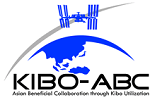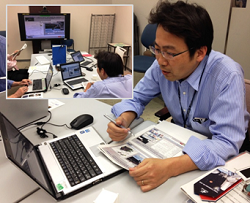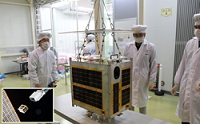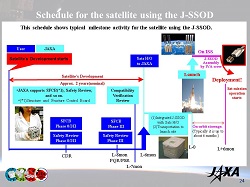This is an archive of information released in the past.
Disclaimer: It may contain broken links or outdated information. Some parts may not function in current web browsers.
*Visit https://humans-in-space.jaxa.jp/en/ for the latest information.

Kibo-ABC members talk with JAXA "J-SSOD" (Small satellites launch and deployment service) Specialist

Mr. Masaharu Takata joined the Kibo-ABC regular monthly web conference on May 19th to give a presentation about the J-SSOD utilization. He is a specialist and an integrator of JEM Small Satellite Orbital Deployer (J-SSOD) who works with satellite engineers and users of the satellite deployment from Kibo.
Mr. Takata started to work for Kibo from the early phase of its development and led the development of the J-SSOD hardware. After achieving the first deployment of J-SSOD, he began to work as an integrator of J-SSOD users.
With his wealth of knowledge and experience with J-SSOD, he gave an overview of J-SSOD, its specifications, and past and future satellite missions with photos. In his presentation, he also described the roles and responsibilities of users and the preparation schedule template of J-SSOD.
All the Kibo-ABC members had a great time and were motivated to utilize J-SSOD for their satellite deployment.
Q&A
Topic 1: General Deployment Opportunity Service
Q. Would you like to share more detail about launching cost? (Vietnam)
A. J-SSOD service fee ( Launch and deployment )1U / 3,000,000 JPY
2U / 6,000,000 JPY
3U / 8,000,000 JPY
50kg class / 104,000,000 JPY
Roles and responsibilities between JAXA and customers were shown in the presentation chart of today's meeting.
Q. Can J-SSOD deploy cube-sat in constellation? How many cube-sats can be released at the same time for the constellation? (Malaysia)
A. Yes, J-SSOD can. For now, 3 to 6 cubesats (1U) can be deployed simultaneously. JAXA is investigating an advanced type of J-SSOD which can deploy 18 cubesats.Q. Who is responsible for the registration of space objects? (Malaysia)
A. It is the customer's (satellite developer's) responsibility, not JAXA.Q. When will 6-U cubesat be available? (Singapore)
A. No development plan for 6U cubesat has been defined, but JAXA is going to discuss it as 6U size cubesat is becoming mainstream.Q. If the J-SSOD proves to be a complete success will any future launches be opened up commercially to universities as an alternative (cheaper and safer) method to launch scientific CubeSat missions? (Australia)
A. Asian/Pacific universities can utilize the J-SSOD if they have a partnership with a Japanese university that has a contract with JAXA. JAXA will be able to provide the required information of the J-SSOD utilization for the Kibo-ABC members.Topic 2: Technical Questions about Satellite Deployment from ISS/Kibo
Q. Following previous procedures to deploy small satellites from ISS, satellites may be kept in ISS for several months. I am not sure about the environment around satellites during that phase, but I think it may have some effect on satellites, especially the potential to run out of battery power because of the low temperature. I hope that you can share more information about the environment and duration of this phase. (Vietnam)
A. Small satellites are kept in stowage locker in the ISS cabin until deployment. Since the ISS cabin is pressurized and at room temperature, the stowage environment does not affect satellites. For batteries, we can make a regulation of the stowage duration to prevent the running out of batteries.Q. Orbital altitude from 380 - 420 km with 100 - 250 day lifespan is too short for 50-kg class satellites. Do you have any plans to improve that in the future? (Vietnam)
A. 100 - 250 day lifespan is for 1U to 3U cubesat. The lifespan of 50kg class satellites is 1 - 2 years. Since the altitude of deployed satellites should be lower than ISS (to prevent collision), it is hard to inject a higher orbit to extend the lifespan.Q. Can J-SSOD support constellation deployment at certain degree phase separation (e.g 3-satellite at 120deg or 4-sat at 90deg in the same orbital plane)? (Singapore)
A. No, J-SSOD cannot.Q. Can J-SSOD deploy cube-sat in Near Equatorial Orbit (NEqO) or is it truly dependent on the ISS orbit? (Malaysia)
A. J-SSOD can only deploy in ISS orbit (Satellite deployment speed is only about 1.5m/sec, and no orbital adjustment device is equipped.).Q. Can J-SSOD eject at a positive elevation angle with positive delta-V to enable cube sat to attain higher altitude? (asking whether the 50kg class microsat with propulsion after deployed into orbit can raise its height such that the 50kg satellite perigee is higher than ISS apogee. This is to ensure long in-orbit life of the 50kg satellite.) (Singapore)
A. No, J-SSOD can deploy only lower altitude for now due to safety reasons.Q. Can satellites with propulsion be deployed from J-SSOD? (Philippines)
A. Electrical propulsion is acceptable, but chemical propulsion is very difficult due to issues with toxicity.| Copyright 2007 Japan Aerospace Exploration Agency | Site Policy |



